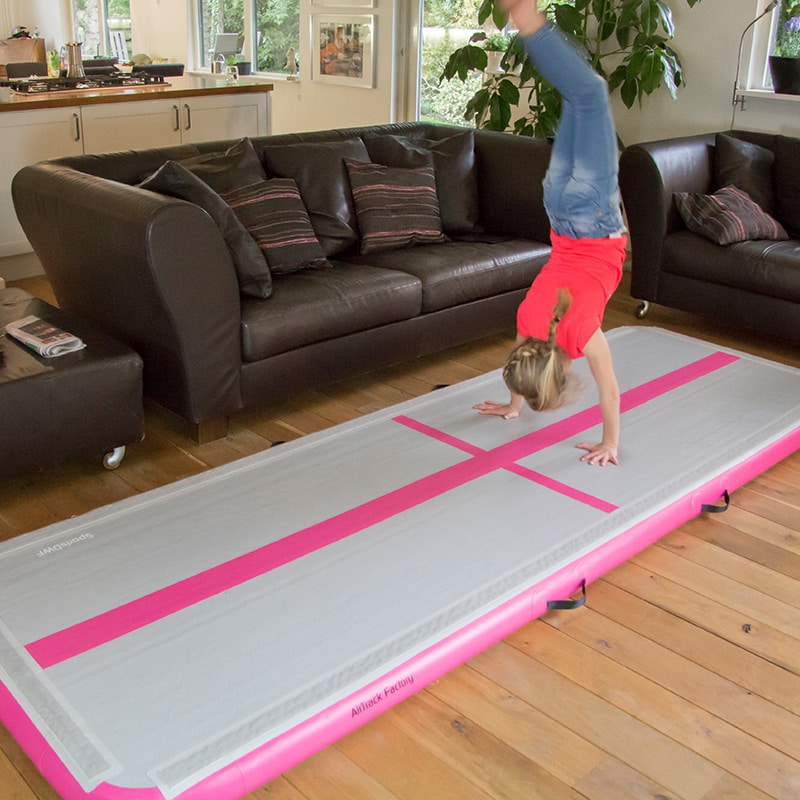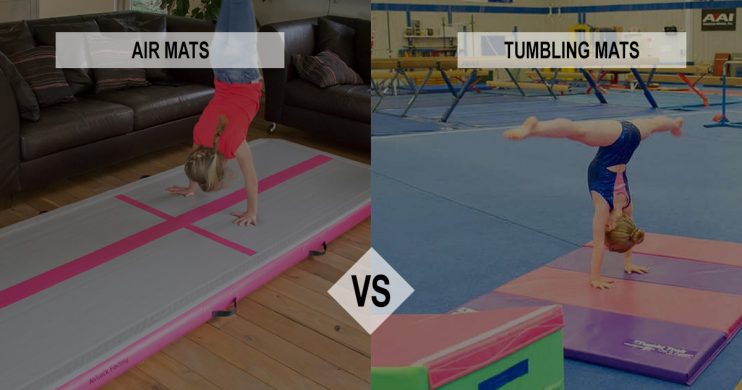One of the great things about gymnastics is that it’s easy to practice without a lot of complicated equipment. This is especially true when you’re first starting out. If there’s one training aid that all aspiring Olympians can benefit from, it’s a dedicated tumbling surface a.k.a mats.
Portable mats and tracks make drilling dangerous skills much safer. Some can even replicate the feeling of performing a picture-perfect pass on an actual spring floor.
Deciding which to spend your money on can make shopping feel like a bit of a battle. Air mat vs. tumbling mat: which one is better for the gymnast looking for a convenient way to train at home?
To crown a winner, it’s necessary to first understand the key differences between these two styles of equipment and the specific uses that each is uniquely suited for.
What’s the Difference?
An Air mat is a type of inflatable tumbling surface (hence the name) designed for use outside of a formal gym setting. Thanks to their tough construction and internal pressure, Air mats offer a degree of rebound almost identical to that of a spring floor.
Increased rebound has two big advantages. For one, it boosts the gymnast’s power, which is useful for mastering skills like handsprings, flips, and layouts that require a little more oomph. It also reduces the risk of injury in the event of an accident or technical mishap.
By comparison, tumbling mats are made up of individual segments of foam covered in leather, vinyl, or soft PVC—simple but effective. Along with shock absorption, the biggest appeal of traditional mats is their foldability. It only takes a few seconds to set up a mat before a tumbling session, and you can stow it away with equal ease when you’re done.

When it comes right down to it, Air mats outperform traditional tumbling mats in the ways that matter most. That said, each piece of equipment comes with distinct pros and cons that are worth considering if you want to make an informed investment.
Air Mat vs. Tumbling Mat: Head-to-Head
You know the line from that old song, “Anything you can do, I can do better”? That’s Air mats in a nutshell. But mats have their place too, and may realistically be the better option for some gymnasts, depending on their goals, budget, and available storage space. This is also another concern that customers have when deciding between inflatable air mat vs. gym mat.
Size
Air mats come in a variety of sizes. Standard models tend to run about 10-15 feet long and 3-6 feet wide, while larger versions can reach lengths of up to 50 glorious feet. More room means more room for error. Air mats are therefore the superior choice for gymnasts looking for the most protection possible.
Like inflatable mats, traditional tumbling mats come in a wide range of shapes and sizes. A typical size is 8 feet in length and 4 feet in width and may be anywhere from 1-3 inches thick. This makes them perfect for practicing single skills, such as standing back tucks, but not so much for longer, more complex sequences.
To pull off a proper tumbling pass, you’d need to purchase multiple mats and connect them end-to-end. Needless to say, doing so will add to your total expense.
Safety
Air mats are generally much more forgiving than mats, seeing as how they’re basically little clouds you can conjure with an air compressor. Even the gnarliest falls usually only result in a painless bounce or two, after which you’ll be ready to stand back up and give it another go.
The catch? Their cushioning is entirely reliant on air pressure. If you pop an Air mats—which has been known to happen—you’ll not only be out a considerable amount of money but also be more likely to hurt yourself as your crash pad slowly vanishes beneath you.
Tumbling mats are impervious to punctures since they’re made of foam. However, a couple of inches of dense foam just doesn’t compare to 4-8 inches of pure air-light resilience.

Comfort
Tumbling on an inflatable mat takes some getting used to. It’s a little different from tumbling on a spring floor and a lot different than playing around in the yard or a carpeted living room. Once you’ve grown accustomed to the bounce-back, though, you’ll undoubtedly prefer the springy, weightless feeling that only an Air mat can provide.
Tumbling mats serve one main function, which is absorbing impact. For this reason, they actually make it harder to generate force while blocking, meaning they’re not ideal for tumbling.
As a rule, mats are most appropriate for gymnasts seeking extra security while practicing individual skills and short sequences they’re not totally comfortable with.
Convenience
Convenience is one area where tumbling mats can’t be beaten. Whenever you feel like practicing, all you have to do is grab your mat, stretch it out on a flat, stable surface, and you’re ready to rock. Putting it up afterward is likewise a cinch—you just perform those same couple of steps in reverse.
Setting up an Air mat involves quite a bit more work. If you have plenty of room indoors or live somewhere with fair year-round weather, you might consider leaving your mat inflated. Assuming that’s not an option, you’ll have to blow it up every time you want to use it, then let it deflate before you can return it to storage.
Despite their time-consuming setup, inflatable mats boast far greater storage potential. It’s possible to compress a fully deflated Air mat down to a couple cubic feet!
Price
Inflatable tumbling mats are super safe, responsive, and easy to store. But all those perks don’t come cheap. You can expect to pay several hundred dollars for a halfway decent air mat of the smallest size; larger models can climb into the thousands.
Unfortunately, this kind of price tag makes them inaccessible to gymnasts who don’t have a ton of disposable income.
Tumbling mats are way more affordable than inflatable mats. A single 4-foot by 8-foot mat will rarely run you more than $100. At that rate, you could get several mats for what you would pay for a basic air mat. This might be the way to go if you don’t mind sacrificing some hang time.
Durability
Generally speaking, mats have longer lifespans than inflatable tumbling mats. Visit any commercial gym and you’ll find mats that have been taking a daily pounding for years. When they do start to wear out, it’s often a gradual process. The cover material may fray and split, but the foam itself will remain intact.
On the other hand, there’s no shortage of air mat customers happy to report that their mats have held up well over time. Most suppliers guarantee around two years of regular use, but it’s not uncommon for industry-leading brands to last for upward of 5-7 years.
It’s a close one, but in terms of durability, tumbling mats have an edge over air mats.
So Which One Is Best?
That’s a bit of a loaded question. Both have their strengths and weaknesses. The better question might be, “Which is best for me?” The answer comes down to a few straightforward guidelines.
Go with an Air Mat if…
- You want to practice longer passes and high-level skills. Because inflatable mats are bigger and bouncier, they’re the best choice for serious tumbling.
- Limited storage space is an issue. You can easily fit a deflated Air mat in a closet, on a shelf in your garage, under your bed, or even in the trunk of your car.
- You have more money to spend. Chances are, you’ll conclude that the added benefits are worth the higher price point.
Go with a Tumbling Mat if…
- You want to focus on standalone skills and simple sequences. Mats make excellent safety nets that can go just about anywhere you might want to practice.
- Durability is a primary concern. You’ll likely get much more mileage out of a tumbling mat than you would out of an air mat.
- You’re buying on a budget. You can snag one or more deluxe mats for a fraction of the cost of a base-level inflatable mat.
The Bottom Line
All in all, an air mat will make for a more fun, safe, and open-ended tumbling experience, but only if price and storage space are no objects.
If you’re in the market for something more financially practical, it’s hard to go wrong with a quality tumbling mat. Just ask any gold medalist who got their start learning round-offs and walkovers in the backyard.
Regardless of which type of equipment you end up choosing, you’ll no doubt find a sense of security in the fact that you’re making safety a priority.
Did this article help you upgrade your home gym equipment? If so, hit “Like” and “Share” to do your part in broadcasting it to other gymnasts in need. And if you’ve got any questions or product recommendations, be sure to sound off in the comments!


3 Comments on “Air Mat vs. Tumbling Mat: Which Is Best for Gymnastics?”
I still don’t know which one to chose? Maybe a little more info?
Air track is so much better! OMG i can do a twist!! so easy now!!
Lots of great information but still stumped on which one to buy…. Wish there were a list of skills on each May to narrow down which is what I am looking for.